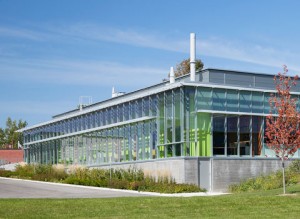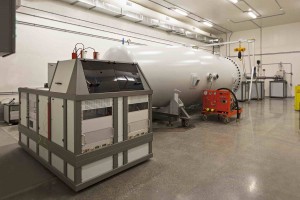
Queen’s lab to help with nuclear plant design
September 14, 2015
By
CCE

Reactor Materials Testing Laboratory (RTML), Queen’s University, Kingston, Ont. Photo: Diamond Schmitt Architects.
This article was revised September 17, 2015.
A specialized lab designed to simulate the conditions inside a nuclear reactor and test the effects on materials has opened at Queen’s University in Kingston, Ontario.
The Reactor Materials Testing Laboratory (RMTL) is a one-storey 600-sq. m building. It contains an accelerator that generates a beam of high energy protons. The accelerator is encased in a reinforced concrete chamber with walls two metres thick to seal it off from the surrounding offices, labs and other spaces.
Researchers will use the facility to investigate how materials respond to stress and temperature inside a nuclear power plant, leading to safer and more efficient designs. In a nuclear power reactor materials behave differently than in conventional applications due to the damage caused to their atomic structure. The proton accelerator will enable the researchers to draw parallels with the way materials are damaged in a nuclear reactor.
In order for researchers to safely access the target rooms and accelerator, a complex system of physical barriers, fail safe devices and safety interlocks were put in place. These include a series of sliding doors, some weighing as much as 10 tonnes. There is an analogue electrical system of warning devices, radiation detectors and a sequential keyed activation system. The system uses a single key that must be used to activate more than 20 check points in the correct sequence in a timely manner before it can then be used to activate power to the accelerator.
The building was designed by as a joint venture between Diamond and Schmitt Architects and Shoalts and Zaback Architects . of Kingston. Read Jones Christoffersen were structural engineers, H.H. Angus were mechanical, electrical, communications and security engineers, Josselyn Engineering did civil engineering, and Aercoustics were vibration and acoustics consultants.
“The uniqueness of this facility is a testament to the innovative approaches being used by the Faculty of Engineering and Applied Science to enable world-leading research and to educate our students,” said Dr. Mark Daymond, the director of the laboratory.

Proton Accelerator inside the Rector Materials Testing Laboratory, Queen’s University. Photo: Diamond Schmitt Architects.